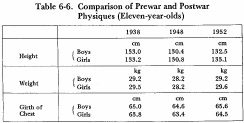- 現在位置
- トップ > 白書・統計・出版物 > 白書 > JAPAN'S MODERN EDUCATIONAL SYSTEM > (12)Physical Education and Athletics
(12)Physical Education and Athletics
The abolition in 1945 of bayonet drill, military drill, and the martial arts in the schools meant that physical education consisted primarily of games and sports, in contrast to the formal physical training programs of the wartime. However, the traditional arts of judo, kyudo (archery), and kendo (swordsmanship) were adapted for use in the new system in 1950, 1951, and 1952, respectively.
Hygiene in the schools had heretofore been confined to the prevention and care of injury and disease. The physical education subject was expanded in 1947 to include a broader health program that stressed the promotion and maintenance of good health. The aim of physical education set forth in the 1949 Course of Study for Elementary School Physical Education (Tentative Plan) was to enhance the physical development of children and upbuild their good character. In 1949 the qualifications and titles for the nursing teacher (yogo kundo) and other school health official were upgraded as those for the new nursing teacher (yogo kyoyu) and assistant nursing teacher in the Law for Licensing Educational Personnel.
School lunch programs, which had been suspended during the war, were resumed in January, 1947, using supplies provided by the Licensed Agencies for Relief of Asia (LARA) and the United States Army. The lunch programs were scanty during the first several years, even though additional provisions, such as skim milk, and support came from the Ministry of Education and the United Nations International Children's Emergency Fund (UNICEF). By 1950 the lunch program had become a regular feature of the school routine in the eight major cities and included bread, milk, and a side dish. By 1951 more than 10,000 schools with nearly eight million pupils benefited from the school lunch service.
To bolster the sagging morale of the nation following Japan's defeat, some middle-ranking sportsmen proposed that a National Athletic Meet be held in 1946 in Kyoto, which had escaped damage during the war. The Meet was sponsored by the Greater Japan Amateur Sports Association (later renamed the Japan Amateur Sports Association in November, 1948) and 5,377 athletes, each bringing his own provisions, gathered to demonstrate their commitment to sports and their desire to participate in the rebuilding of Japan. Since that time a similar meet has been held annually in various parts of the country. Known as the Kokutai, this National Athletic Meet has played an important role in promoting the construction of sports facilities in rural areas and active participation in sports activities throughout the country. The Ministry of Education subsidizes the operating expenses of the annual meets.
As early as 1949, Japanese athletes rejoined international athletic competition, taking part first in the all-American swimming championship series. The success of Furuhashi Hironoshin (1928 - ) in these meets became a symbol of Japan's reacceptance into international society. By 1952 international interchange in the sports arena had become commonplace, and Japan participated actively in the Fifteenth Olympic Games.
Table 6-6. Comparison of Prewar and Postwar Physiques (Eleven-year-olds)

お問合せ先
(C)COPYRIGHT Ministry of Education, Culture, Sports, Science and Technology
-- 登録:平成21年以前 --